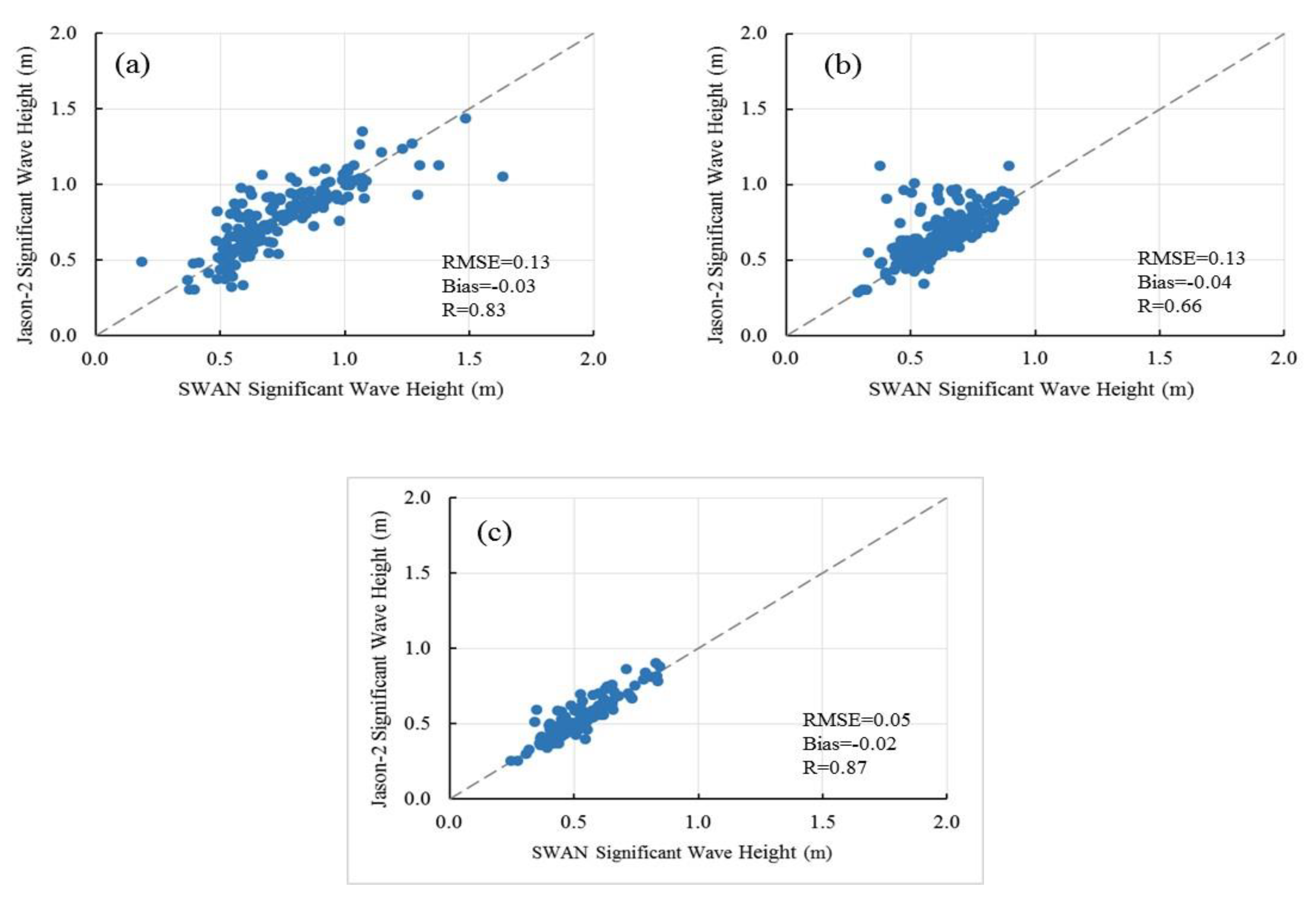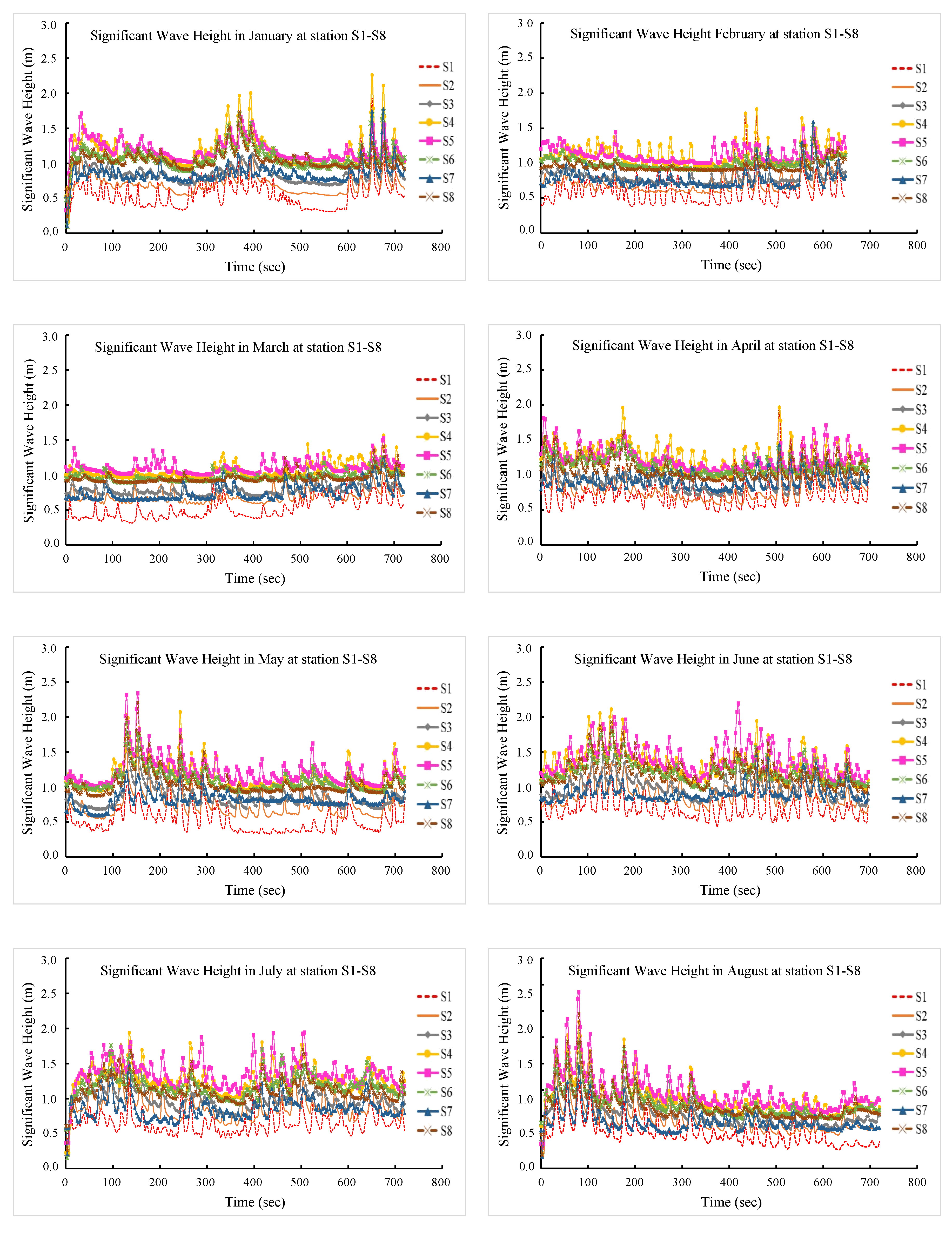Wave Energy Potential and Simulation on the Andaman Sea Coast of Thailand
Abstract
:1. Introduction
2. The Study Area and Data
2.1. The Study Area
2.2. Bathymetry Data
2.3. Wind Data
2.4. Wave Data
3. Numerical Wave Model
3.1. Numerical Setup in SWAN Model
3.2. Wave Power
4. Computational Fluid Dynamics (CFD)
4.1. Computational Domain and Numerical Setup in CFD
4.2. Linear Wave Theory
5. Results and Discussion
5.1. Wave Comparison
5.2. Analysis of Data Validation
5.3. Significant Wave Height
5.4. Wave Power
5.5. Wave Energy Potential in Thailand
5.6. Wave Simulation by CFD
6. Conclusions
Author Contributions
Funding
Acknowledgments
Conflicts of Interest
References
- Hirunwong, P.; Singhaseni, S. The future electricity of Thailand sufficient but risky. In Focused and Quick (FAQ) Issue 102; Bank of Thailand: Bangkok, Thailand, 2015. (in Thai) [Google Scholar]
- Enerdata, Global Energy Statistical Yearbook 2017. Available online: https://yearbook.enerdata.net (accessed on 3 August 2015).
- Energy Policy and Planning Office (EPPO). Energy Statistics of Thailand Year 2016; Ministry of Energy: Bangkok, Thailand, 2017.
- Energy Policy and Planning Office (EPPO), Overview of Thailand Integrated Energy Blueprint (TIEB); Ministry of Energ: Bangkok, Thailand, 2015.
- Lavidas, G.; Venugopal, V. Application of numerical wave models at European coastlines: A review. Renewabe Sustain. Energy Rev. 2018, 92, 489–500. [Google Scholar] [CrossRef] [Green Version]
- Akpinar, A.; Vledder, G.; Komurcu, M.; Ozger, M. Evaluation of the numerical wave model (SWAN) for wave simulation in the Black Sea. Cont. Shelf Res. 2012, 50, 80–99. [Google Scholar] [CrossRef]
- Akpinar, A.; Komurcu, M. Assessment of wave energy resource of the Black Sea based on 15-year numerical hindcast data. Appl. Energy 2013, 101, 502–512. [Google Scholar] [CrossRef]
- Appendini, C.M.; Urbano-Latorre, D.P.; Figuerroa, B.; Dagua-Paz, C.J.; Torres-Freyermuth, A.; Salles, P. Wave energy potential assessment in the Caribbean low level jet using wave hindcast information. Appl. Energy 2015, 137, 75–84. [Google Scholar] [CrossRef]
- Wannawong, W.; Ekkawatpanit, C.; Kositgittiwong, D. Assessment of wave energy resource from the deep sea to the coastal area of Gulf of Thailand. In Proceedings of the International Conference Grand Renewable Energy, Tokyo, Japan, 27 July–1 August 2014. [Google Scholar]
- Thanathanphon, W.; Nakapakorn, K.; Phoomjamnong, N.; Luang-aram, W. Application of SWAN model for Investigate Save Characteristics in the Gulf of Thailand During Typhoon Muifa. J. Sci. Technol. 2011, 3, 40–50. [Google Scholar]
- Thanathanphon, W.; Wannawong, W.; Srisomporn, P.; Boonya-aroonnet, S. Development of an operational wave forecasting system for the Gulf of Thailand by using Simulating WAves Nearshore (SWAN) Model. In Proceedings of the Conference 20th National Convention on Civil Engineering, Khon Kaen, Thailand, 14–16 May 2014. [Google Scholar]
- Hong, Y.; Waters, R.; Bostrom, C.; Eriksson, M.; Engstrom, J. Review on electrical control strategies for wave energy converting systems. Renew. Sustain. Energy Rev. 2014, 31, 329–342. [Google Scholar] [CrossRef]
- Leao, R. Wave power conversion systems for electrical energy production. In Proceedings of the International Conference of Renewable Energy and Power Quality (ICREPQ), Santander, Spain, 12–14 March 2008. [Google Scholar]
- Drew, B.; Plummer, A.R.; Sahinkaya, M.N. A review of wave energy converter technology. Proceedings of the Institution of Mechanical Engineerings. Part A J. Power Energy 2009, 223, 887–902. [Google Scholar] [CrossRef] [Green Version]
- Lopez, I.; Andreu, J.; Ceballos, S.; De Alegria, I.M.; Kortabarria, I. Review of wave energy technologies and the necessary power-equipment. Renew. Sustain. Energy Rev. 2013, 27, 413–434. [Google Scholar] [CrossRef]
- Phomkaeo, K.; Punyasompun, S. Study of electric power generation from coast wave. Princess Naradhiwas Univ. J. 2013, 5, 37–46. [Google Scholar]
- Tanizawa, K.; Naito, S. A study on parametric roll motions by fully nonlinear numerical wave tank. In Proceedings of the 7th International Offshore and Polar Engineering Conference, Honolulu, HI, USA, 25–30 May 1997. [Google Scholar]
- Connell, K.O.; Cashman, A. Development of a numerical wave tank with reduced discretization error. In Proceedings of the International Conference on Electrical, Electronics, and Optimization Techniques (ICEEOT), Chennai, Tamilnadu, Indian, 3–5 March 2016. [Google Scholar]
- Dimitrova, M.; Kortcheva, A.; Galabov, V. Validation of the operational wave model WAVEWATCH III against altimetry data from Jason-2 satellite. Bul. J. Meteo Hydro 2013, 18, 4–17. [Google Scholar]
- Kanbua, W.; Supharatid, S.; Tang, I.M. Ocean Wave Forecasting in the Gulf of Thailand during Typhoon Linda 1997: WAM and Neural Network Approaches. Sci. Asia 2005, 31, 243–250. [Google Scholar] [CrossRef]
- Ochi, M.K. Ocean Waves: The Stochastic Approach; Cambridge University Press: Cambridge, UK, 1998. [Google Scholar]
- Hirt, C.W.; Nichols, B.D. Volume of fluid (VOF) method for the dynamics of free boundaries. J. Comput. Phys. 1981, 39, 201–255. [Google Scholar] [CrossRef]
- Srinivasan, V.; Salazar, A.J.; Saito, K. Modeling the disintegration of modulated liquid jets using volume-of-fluid (VOF) methodology. Appl. Math. Modeling 2011, 35, 3710–3730. [Google Scholar] [CrossRef]
- Energy Policy and Planning Office (EPPO). Alternative Energy Development Plan (AEDP); Ministry of Energy: Bangkok, Thailand, 2015.
- Kompor, W.; Ekkawatpanit, C.; Kositgittiwong, D. Assessment of ocean wave energy resource potential in Thailand. Ocean Coast. Manag. 2018, 160, 64–74. [Google Scholar] [CrossRef]
- Zheng, C.W.; Zhuang, H.; Li, X.Q. Wind energy and wave energy resources assessment in the East China Sea and South China Sea. Sci. China Technol. Sci. 2012, 55, 163–173. [Google Scholar] [CrossRef]
- Mirzaei, A.; Tangang, F.; Juneng, L. Wave energy potential assessment in the central and southern regions of the South China Sea. Renew. Energy 2015, 80, 454–470. [Google Scholar] [CrossRef]
- Teillant, B.; Costello, R.; Weber, J.; Ringwood, J. Productivity and economic assessment of wave energy project through operational simlations. Renew Enegy 2012, 48, 220–230. [Google Scholar] [CrossRef] [Green Version]













| Month | The Highest Significant Wave Height | The Lowest Significant Wave Height | ||
|---|---|---|---|---|
| Significant Wave Height (m) | Station | Significant Wave Height (m) | Station | |
| January | 2.26 | S4 | 0.30 | S1 |
| February | 1.77 | S4 | 0.37 | S1 |
| March | 1.56 | S4 | 0.31 | S1 |
| April | 1.97 | S4 | 0.46 | S1 |
| May | 2.34 | S5 | 0.32 | S1 |
| June | 2.19 | S5 | 0.43 | S1 |
| July | 1.94 | S5 | 0.20 | S3 |
| August | 3.36 | S5 | 0.23 | S2 |
| September | 2.25 | S4 | 0.42 | S1 |
| October | 2.04 | S4 | 0.41 | S1 |
| November | 2.59 | S4 | 0.42 | S2 |
| December | 2.02 | S5 | 0.38 | S1 |
| Month | The Highest Wave Power | The Lowest Wave Power | ||
|---|---|---|---|---|
| Wave Power (kW/m) | Station | Wave Power (kW/m) | Station | |
| January | 5.54 | S4 | 0.77 | S1 |
| February | 4.35 | S4 | 0.93 | S1 |
| March | 3.49 | S4 | 0.74 | S1 |
| April | 4.08 | S4 | 0.91 | S1 |
| May | 6.08 | S5 | 0.74 | S1 |
| June | 5.26 | S5 | 0.75 | S1 |
| July | 4.54 | S5 | 0.44 | S3 |
| August | 10.19 | S5 | 0.53 | S2 |
| September | 5.40 | S4 | 1.02 | S1 |
| October | 4.63 | S4 | 0.98 | S1 |
| November | 6.60 | S4 | 0.86 | S2 |
| December | 4.73 | S5 | 0.74 | S1 |
© 2020 by the authors. Licensee MDPI, Basel, Switzerland. This article is an open access article distributed under the terms and conditions of the Creative Commons Attribution (CC BY) license (http://creativecommons.org/licenses/by/4.0/).
Share and Cite
Foyhirun, C.; Kositgittiwong, D.; Ekkawatpanit, C. Wave Energy Potential and Simulation on the Andaman Sea Coast of Thailand. Sustainability 2020, 12, 3657. https://doi.org/10.3390/su12093657
Foyhirun C, Kositgittiwong D, Ekkawatpanit C. Wave Energy Potential and Simulation on the Andaman Sea Coast of Thailand. Sustainability. 2020; 12(9):3657. https://doi.org/10.3390/su12093657
Chicago/Turabian StyleFoyhirun, Chutipat, Duangrudee Kositgittiwong, and Chaiwat Ekkawatpanit. 2020. "Wave Energy Potential and Simulation on the Andaman Sea Coast of Thailand" Sustainability 12, no. 9: 3657. https://doi.org/10.3390/su12093657
APA StyleFoyhirun, C., Kositgittiwong, D., & Ekkawatpanit, C. (2020). Wave Energy Potential and Simulation on the Andaman Sea Coast of Thailand. Sustainability, 12(9), 3657. https://doi.org/10.3390/su12093657






